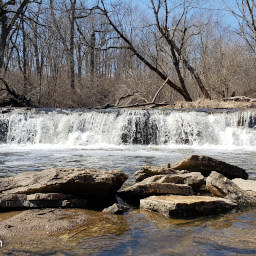| Rating | ★★★★★(5/5) |
| Overall Difficulty | Moderate |
| Navigation Difficulty | Easy |
| Distance | 1.5 miles roundtrip |
| Time | 1 hour |
| Terrain | Strenuous climbing |
| Best Seasons | Spring, Summer, Fall |
| Family Friendly | No |
| Dog Friendly | Yes |
| Accessible | No |
Highlights
- Sand dunes in the Midwest
- Views of Lake Michigan and surrounding area
- Learn about the sand dune ecosystem at the nature center
Hike Summary
This is probably one of the hardest 1.5 mile hikes in the entire Midwest. Climbing sand dunes is much more difficult than climbing a hill because the sand sinks with every step -- two steps forward, one step backward. However, given the short distance, most hikers should be able to complete this challenge successfully. There are stairs to climb the tallest of the three dunes, and there is an alternative route to skip the final climb if you feel unable to continue. Your effort will be rewarded with beautiful views of Lake Michigan, and on a clear day you may be able to see the silhouette of Chicago in the distance. The Indiana Dunes are spectacular, and a quote from the famous Chicago poet Carl Sandburg written on a wall in the nature center agrees: "Those Dunes are to the Midwest what the Grand Canyon is to Arizona and the Yosemite to California."
Dogs are allowed on leash, but prohibited by the beach and lakeshore (there are lifeguards so you will get yelled at). In addition, ensure that your dog does not walk off the trail because this will damage the delicate plants in this environment. Although the trail is short, the steep hills won't be fun for younger children; trail number 3 is a better choice, or else you can just spend the day at this safe beach with lifeguards. When I went on a toasty Friday afternoon, the beach was packed, but I only saw a handful on the trail. I would expect more people on the trail on a weekend, but not nearly as many as you may see on the beach. The entire trail is sand, so the downhill sections will be much easier on the knees than on other similarly sized hills. Finally, it is extremely important to remain on the trail in this park, especially when there are stairs or boardwalks -- think about how easy it is to kill a plant growing in sand.
I highly recommend that you start this trail from the nature center rather than the beach. The trails leading from the beach are hard to follow, lacking the numbered poles for navigation, and climb sand dunes without the shady forest found on the rest of this hike, so heed this advice especially on a hot day. In addition, it is difficult to discern which trails near the beach are official and you are likely to wander off-trail when you are lost, harming the fragile ecosystem and eroding the dunes. In contrast, the trails from the nature center are easy to follow, with signs and poles indicating the trail number corresponding to a route on the official park map and special signs for the Three Dunes Challenge.
Definitely stop in the nature center before embarking on the hike. Here, you will learn more about the native plants and the theory of ecological succession, a theory by H.C. Cowles from the University of Chicago originally developed by researching these very dunes that describes the development and transition of plants from one environment to the next and is applicable to different environments worldwide. If you biked or walked here from the train station, this is also a great chance to cool down in air conditioning, use the restroom, and drink water before heading back outside.
From the nature center, follow signs for trail 8 and the Three Dunes Challenge (as pictured below). Turn left at the first intersection, then you will soon start the climb the top of the first tall dune, Mt. Jackson, at 176 feet above Lake Michigan. Pay attention to the surrounding plants and watch for the transition from hardwood forest to coniferous forest to grassland that occurs as you walk closer to Lake Michigan (ecological succession just like you learned at the nature center).

Follow these signs to take the Three Dune Challenge
View full size
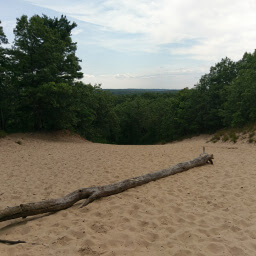
Looking down from the top of Mt. Holden
View full size
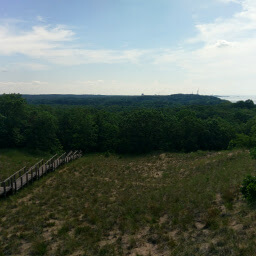
The view from Mt. Tom
View full size
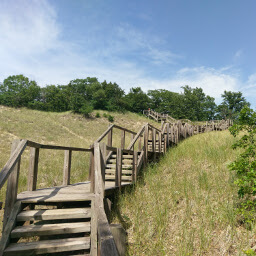
The endless staircase on the descent of Mt. Tom
View full size
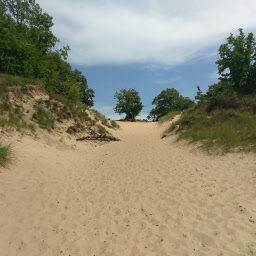
Looking up Devil's Slide
View full size
Directions
By Train
This is one of those rare hiking destinations accessible via public transportation. Starting from Millennium Station in Downtown Chicago, take the South Shore Line eastbound toward South Bend and get off at the Dune Park station. Tickets are $17 roundtrip -- for more information and train schedules, visit the South Shore Line website. Since you do not have to pay the entrance fee as a pedestrian or cyclist, taking the train will save you a bit of money when you calculate the cost of driving around 100 miles roundtrip from Chicago.
Getting to the trailhead requires an approximately 2.3 mile walk. Alternatively (the easiest way), you can bring your bike on the train, but note that only certain trains allow bikes; given the current schedule, you cannot do this trip on a weekday if you start from Chicago and hope to bring your bike. From the station platform, you should be able to see the start of a paved trail on the other side of the tracks. Walk to the west end of the platform and look for the pedestrian crossing, then continue down the paved trail into the forest heading north. Eventually, the trail ends and you must walk in the bike lane on the side of the road. Walk through the main park entrance (it is essential that you walk through the main entrance rather than taking a shortcut -- there are many signs on other trails leading into the park that state pedestrians and cyclists need to use the main entrance), then turn right at the traffic circle. Follow this road past the campground, then turn left following the sign pointing to the nature center.
By Car
From Chicago, take Interstate 94 east. In about an hour, exit at Indiana Highway 49 heading north. Continue on this road to the main park entrance, pay the fee, then turn right at the traffic circle. Drive past the campground, then turn left following the sign pointing to the nature center.
Google Maps Directions
Parking, Fees, and Facilities
The vehicle entrance fee for Indiana Dunes State Park is higher than other Indiana State Parks, costing $7 for vehicles with Indiana plates or $12 for out of state vehicles for a one-day pass. If you come here often, an annual pass is $50 for Indiana residents and $70 for non-residents. The parking lot is adjacent to the nature center with bathrooms and a picnic area.
